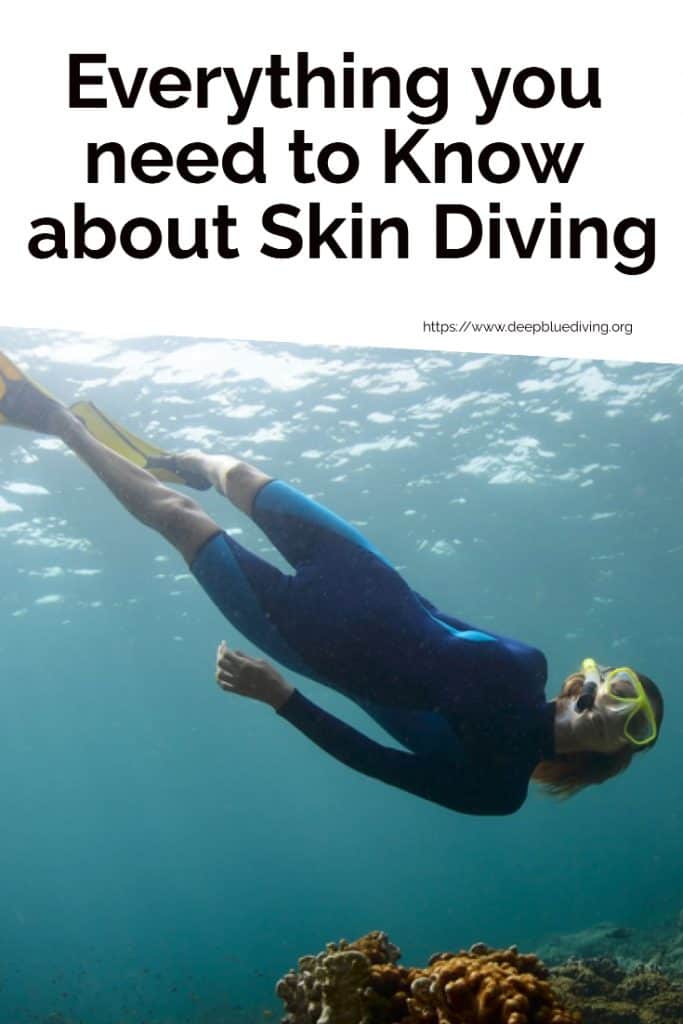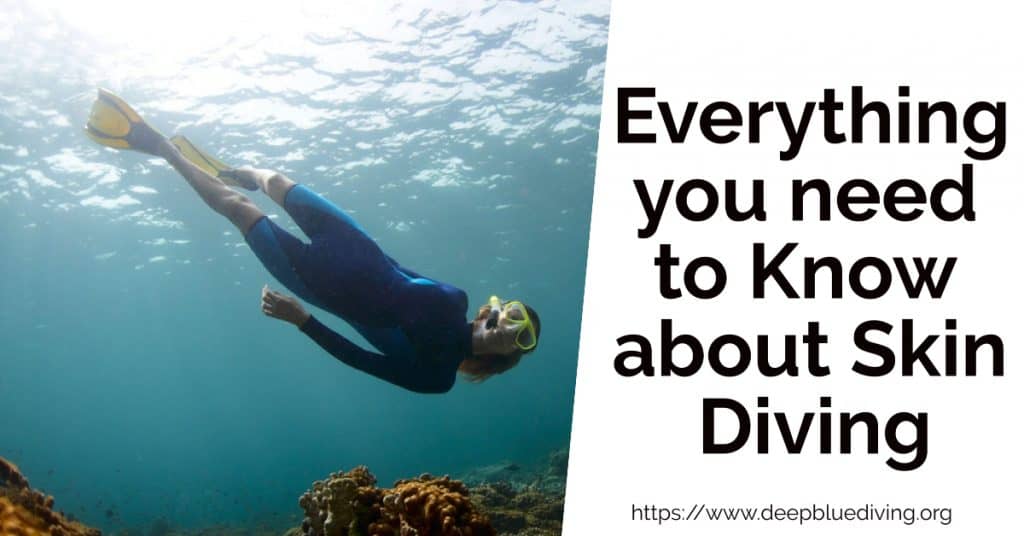Everything you need to Know about Skindiving – A Deep Dive
Skindiving is one of the best ways you can experience the aquatic world. As a skin diver, you don’t require a lot of gear which makes it easy and affordable!
It is quite difficult to keep up with all the terms used to define jumping into the water because all the different disciplines seem to overlap in one way or the other. After saying this, however, even those slight changes can make a huge difference in your dive, and how you experience the aquatic world and life beneath.
We’ll take a deep-dive into what it means to be a skin diver and touch on other water disciplines like free diving, scuba diving, and snorkeling. There are some variations in each; some clearly defined and some a little muddled.
Because of these grey areas of definition, some skin divers might have a different idea of what the definitions should be. This is just a way to define the sport of skin diving for those who are trying to get a basic understanding of it, without the overwhelming details and arguments.
How is Skin Diving Defined?
Skin diving is a form of experiencing the aquatic world while holding your breathing for a period of time while you go observe marine life or reefs that you see underneath. Skindiving requires the skin diver to wear a mask and snorkel at the surface of the water, breathe through the tube, and observe everything underneath, until they see something that sparks their interest.
When something that the skin diver wants to examine more closely has been spotted, a long-held breath dive is taken into the water closer to where the skin diver wants to be. Skin diving requires a lot of practice and stamina especially to be able to hold your breathing for long periods of time while underwater.
Scuba diving certainly also requires practice and experience but having a breathing apparatus with you underwater makes things easier. A skin diver relies on the air in her lungs when skin-diving while scuba diving is done with a tank of air to provide the breathing gas.
Training to Skin Dive
As mentioned above, training to skin dive does require a bit of stamina and some training. As a skin diver, you need enough strength to be able to propel your body into the water and be able to maneuver it for a period of time while diving underwater.
This training for snorkeling skin diving not only requires some sort of physical exercise but also a certain level of swimming skills. People who don’t know how to swim very well are better off snorkeling, rather than venturing under the surface of the water and skin dive.
Apart from strength and stamina, the skin diver needs to be trained to hold their breathing over long periods of time to be able to stay underwater when diving. That is pretty close to what you’d have to also do as a freediver and here’s where skin divers overlap. The following are a few tips on how to prepare for the dive, and how to train yourself as a skin diver on how to hold your breathing underwater for longer periods of time when skin diving.
Before Taking the Dive
Before the actual skin dive, it is a good idea to get some training. Yoga and stretching exercises can help improve your posture and flow and help to become a skin diver. These exercises help you become more aware of your body’s movements, and make you more flexible, making your snorkeling skin diving that much more comfortable.
Along with yoga, some form of strength training is a good idea to gain core strength for posture and upper legs for maneuverability when diving. Finally, it is also a good idea to add in some cardio for stamina.
The best form of cardio to do for skindiving training is either running or (for obvious reasons) swimming. The more you practice, the stronger a swimmer you will be, making your snorkeling skin diving experience that much better.
Holding your Breath
Learning how to you hold your breathing underwater for long periods of time takes a lot of patience and practice. The number one rule when holding your breath is keeping your body completely relaxed; the more strain and tension it feels, the more energy it uses up, the harder it is to hold your breath.
Before actually holding your breathing, you need to get your body used to inhale large amounts of air. Make deep breathing a part of your daily practice which then will tremendously help to hold your breath when you’re diving underwater.
Make sure you pick a safe environment like lying down on your bed and start practicing holding your breath, increasing your time over the days. Finally, start practicing by floating face down (with a mask) in the water as if you’re snorkeling but without a snorkel and calculating how long you can hold your breathing for. Keep practicing in and out of the water until you can reach your goal time.
Pro Tip:
Splashing your face with cold water or submerging yourself in cold water slows down your heart, allowing you to hold your breath for longer.
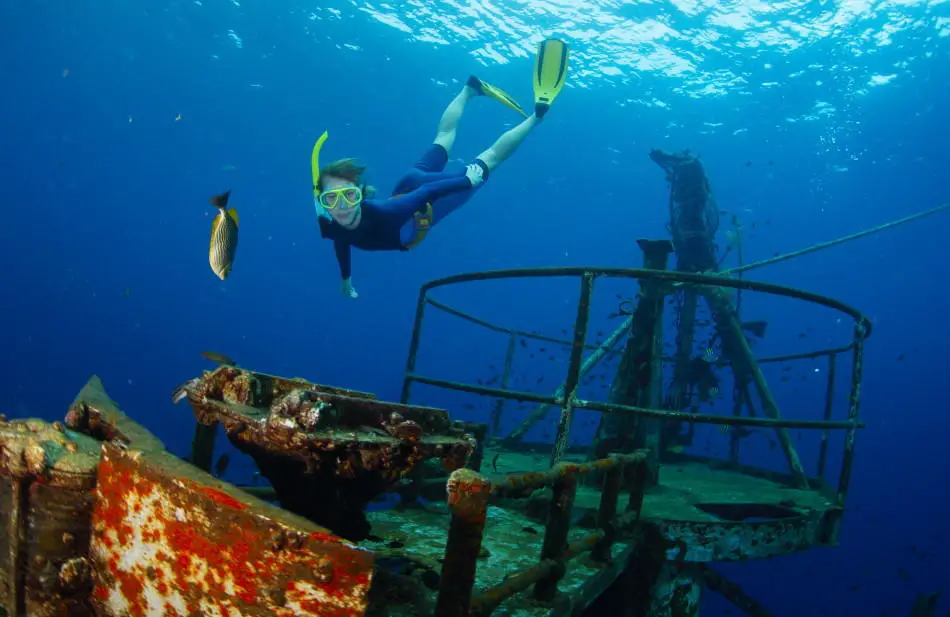
What is the Difference between Skin Diving and Scuba Diving?
Scuba diving, unlike the other three forms of diving, has very defined lines as to why it is called what it is. Scuba or SCUBA means Self Contained Underwater Breathing Apparatus.
This clearly defines what the meaning of scuba diving is. If you are using an apparatus that carries air for you to breathe underwater, you’re scuba diving. This equipment does not rely on surface air as a snorkeling tube does.
Scuba diving allows you to stay underwater for long periods of time, depending on the amount of air you are carrying with you. It also allows for deeper dives, unlike in snorkeling skin diving where you are relying on your lungs to carry your entire air supply.
The reason why snorkeling skin diving is a popular activity even among scuba divers is that it poses a challenge for those who have been scuba diving for a while; skin-diving challenges their stamina and also presents a new way to do what they are so used to doing. The more popular reason, however, is because holding your breath rather than using a breathing device allows you to get closer to marine life while diving without scaring them away with massive bubbles that are produced while breathing through a device.
Skin diving also requires a lot less equipment than scuba diving, making it a lot more accessible to people who want to experience marine life underwater through breath-hold diving but don’t want to go through the hassle of renting out too much equipment.
Finally, scuba diving requires proper training and certifications for a scuba diver to be able to attempt it. For breath-hold skin diving, you are just relying on your own abilities to hold your breathing underwater. Of course, you will go through some training, but it won’t be as in-depth as for scuba diving.
Skin Diving vs. Free Diving – What are the differences?
This is where things get a little confusing. People often use these two words interchangeably. However, there are a few quintessential differences between free diving and skin-diving. Both types are in the category of breath-hold diving.
Freediving is also a form of long breath-hold dives. It does not use any equipment like a snorkel to breathe at the surface.
Skin divers remain on the surface, looking down through the mask, breathing through a snorkel, until they are ready to do a breath-hold dive in and examine things more closely.
With freediving, divers only return to the surface to take a breath and recuperate between dives. The rest of the time is spent submerged in the water.
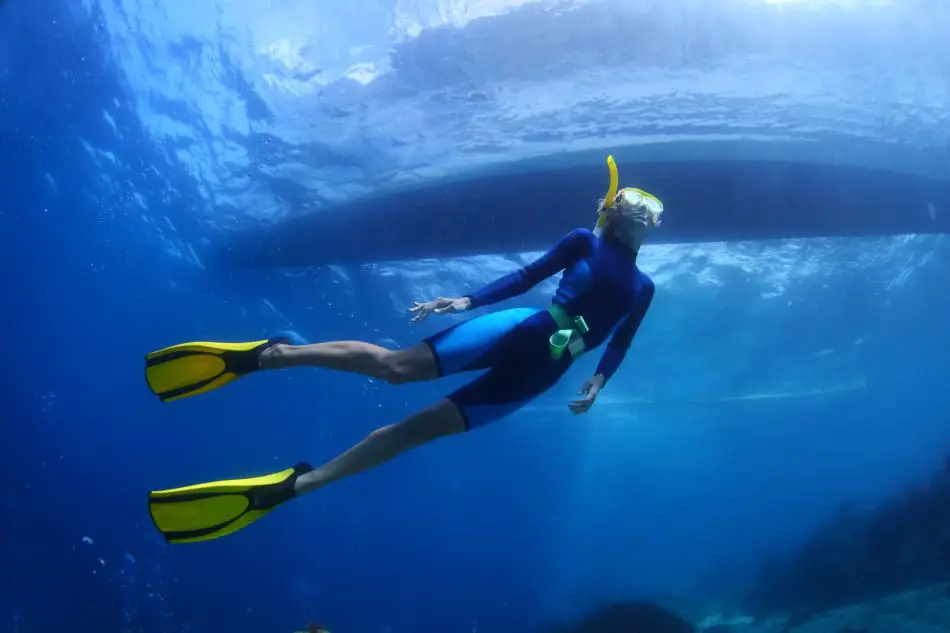
Is Skin Diving Like Snorkeling on Steroids?
Snorkeling is something that the whole family can enjoy. It is not an activity that requires much skill or previous knowledge to be able to do it correctly and enjoy it.
For snorkeling, the person remains at the surface of the water for the entirety of the activity. They use a snorkel to breathe from the surface and a mask to see the wonderful sights below. With snorkeling, you never have to lift your head out of the water to breathe.
Snorkeling, unlike the rest of the diving disciplines, can include a floatation vest, so swimmers can comfortably stay on the surface of the water. Snorkeling skin diving on the other hand sometimes uses weights to help skin divers go underwater, since filling their lungs with air naturally makes their bodies want to float instead of going underwater.
Gear used for snorkeling is extremely basic and easy to come by. A mask, a snorkel, soft fins and very rarely a wetsuit are needed for this activity. It does not require any prior training and can also be done by not-so-strong swimmers.
Skin diving, on the other hand, is snorkeling with a little extra kick. It starts off the same, with swimmers using a mask and snorkel on the surface of the water to see the views below.
When a skin diver spots something he or she really likes and wants to go below the surface, that is where snorkeling skin diving comes into play. Stronger swimmers, with more stamina and a little bit of training, can take the breath-hold underwater skin dive into the water to observe their chosen creature or item.
What Equipment do you need for Skin Diving?
Skin diving can be done with much less equipment than something like scuba diving, but there is still some gear required in order to perform the dive.
Mask
A mask is a standard piece of equipment that is used for every type of dive; scuba diving, free dive, or even snorkeling. This is what equips the skin diver to be able to see underwater with comfort and ease by providing a protecting layer between the eyes and nose and the water.
Masks for skin divers can either be standard scuba diving version, with a silicon nose covering and a screen (tempered glass or polycarbonate) that cover half your face, or they can be the new popular full face masks. Full face masks provide a wider view, with no blockage of the peripheral vision. They also help with jaw fatigue that skin divers get from wearing a mouthpiece with their snorkel as they don’t require you to wear one. These are better suited for shorter dives and snorkeling and are not recommended for scuba diving.
Snorkel
A snorkel and mouthpiece are required for a skin diver to breathe at the surface. The silicone mouthpiece is connected to a tube that opens at the surface above the water allowing the user to breathe. Skin divers keep their faces submerged while swimming at the surface of the water without having to lift their faces because air travels in and out of the tube freely.
Fun fact:
In ancient times, the first version on the snorkel was made out of a hollowed-out reed. The ancient swimmers submerged their entire bodies in the water and breathed through the plant. They could go as deep as the reed was long.
Fins
Fins for skin divers can come in many different shapes and sizes, and also in the way they attach to your feet. Scuba divers usually use fins that are slightly more rigid and long to get speed and agility in the water.
These fins act as an extension of the foot and attach through a strap at the heel. Scuba diving fins aren’t soft like the ones used for snorkeling, nor do they slip on like a shoe covering the entire foot.
Weighted Belt
When you’re snorkeling you want to try to float on the water so you use a vest to help you do that. Whereas with skin diving, you want to stay underwater for as long as possible.
While holding your breath, the air in your body makes it act like a natural floatation device, so the weights are important to help keep you down underwater. They will also help with holding your breath longer because you are struggling less, thus expelling less energy when you’re diving underwater.
Unlike in scuba diving where the belt is worn at the waist, during breath-held dives weighted belts are worn at the hips to allow skin divers to take a deeper breath before the dive.
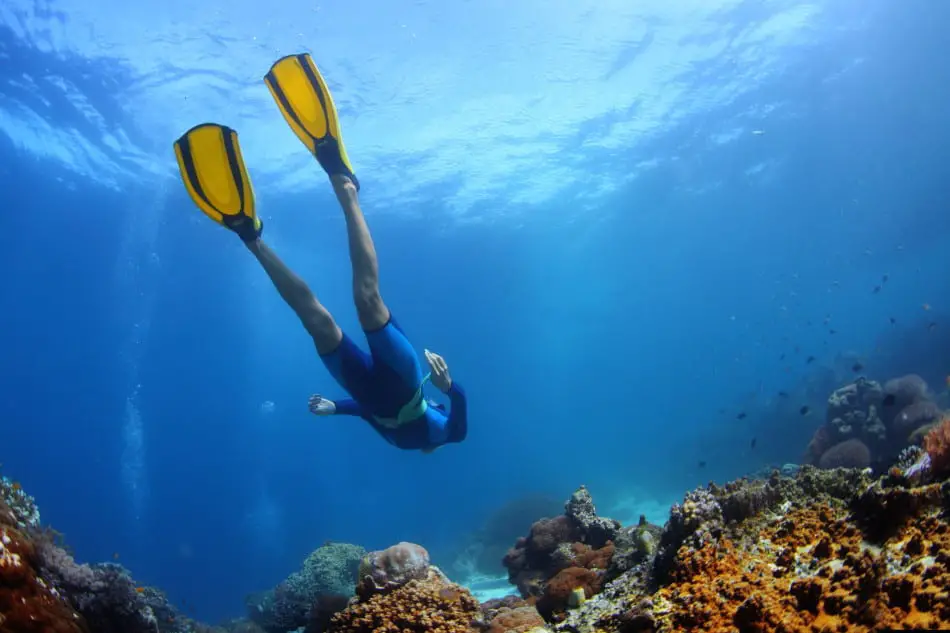
Do you need a suit for skin diving?
With this type of diving, a suit is not a necessity. Depending on the depth of dive, and the temperature of the water, divers will wear a wet suit if necessary. Other protective gear such as rash-guards can be worn to help protect divers from the elements.
Wetsuits protect divers in cooler water, and deeper dives usually do have cold water. However, it is extremely rare that a skin diver will wear a dry suit when skin diving.
Final Thoughts
At the end of the day, what you want to do is jump into the water and observe the beautiful world that exists below. Skin Diving is an easy and not gear-intensive way to experience the aquatic scenery.
Happy Skin Diving!
